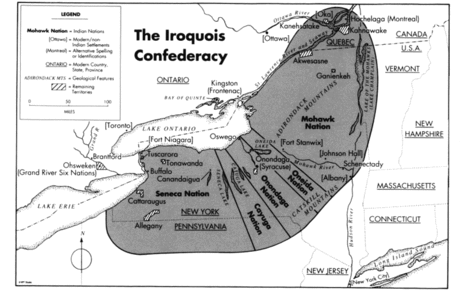Year: 12th Century (?) - Present
The name Iroquois is an Anglicized corruption of a French mispronunciation of an Algokian word meaning "the snakes," an insulting sobriquet applied to the Confederation as enemies of the Algonkian peoples.
At the height of their power, the Haudenosaunee controlled virtually all of New York State, areas of New England and Canada, and a vast area of the Midwest, whose native peoples were tributary to them.
Their participatory form of democratic government was so vital and so effective that the Founders consulted with Iroquois politicians while creating the Articles of Confederation and the Constitution that underlie our representative form of democratic government. The living knowledge and experience of the Iroquois in maintaining a unified government over a large area with a diverse population was to prove critical in informing the American Experiment.
The word "Haudenosaunee" means "People who live in a longhouse," and their conception of themselves as a group is as an extended family that dwells under one roof. In the Confederation, each tribe has certain rights and specific responsibilities.
 |
| The meeting of Deganawidah and Hiawatha |
According to Iroquois tradition, the Confederation was formed through the efforts of two men, Deganawida, an Onondaga, and Hiawatha, a Mohawk. They may have lived as early as 1050 AD. Seen as prophets by the Iroquois, they brought forth a message to the people, known as Gayanashagowa, the Great Law of Peace. This 117 article unwritten constitution still forms the basis of law in the Iroquois Confederacy.
Beginning with the words, "We, the people, to form a union, to establish peace, equity, and order . . ." Gayanashagowa specifies certain universal rules binding all members, describes a joint system of communication and trade, assigns certain duties to certain tribes, and promotes peaceful interaction between the Six Nations.




No comments:
Post a Comment